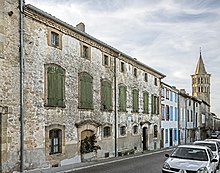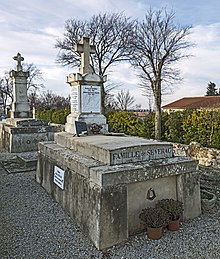
Marie-Joseph Alexandre Déodat de Séverac (pronounced [deoda də sevəʁak]; 20 July 1872 – 24 March 1921) was a French composer.



Life
Séverac was born in Saint-Félix-de-Caraman, Haute-Garonne. He descended from a noble family, [1] profoundly influenced by the musical traditions of his native Languedoc.
He first studied in Toulouse, then later moved to Paris to study under Vincent d'Indy and Albéric Magnard at the Schola Cantorum, an alternative to the training offered by the Conservatoire de Paris. There he took organ lessons from Alexandre Guilmant and worked as an assistant to Isaac Albéniz. He returned to the southern part of France, where he spent much of the rest of his rather short life. His native south was a region that attracted a number of his contemporaries—artists and poets he had met in Paris. [1] His opera Héliogabale was produced at Béziers in 1910. [2]
He died in Céret, Pyrénées-Orientales, Roussillon aged 48.
Music
Séverac is noted for his vocal and choral music, which includes settings of verse in Occitan (the historic language of Languedoc) and Catalan (the historic language of Roussillon) as well as French poems by Verlaine and Baudelaire. His compositions for solo piano have also won critical acclaim, and many of them were titled as pictorial evocations and published in the collections Chant de la terre, En Languedoc, and En vacances.
A popular example of his work is The Old Musical Box ("Où l'on entend une vieille boîte à musique", from En vacances). His masterpiece, however, is the piano suite Cerdaña (written 1904–1911), filled with the local color of Languedoc. His motet Tantum ergo is also still in current use in church settings.
Selected compositions

Operas
- Les Antibels (1907, lost) based on a novel by Émile Pouvillon
- Le Cœur du moulin, poème lyrique in two acts (1908)
- Héliogabale, tragédie lyrique in three acts (1910)
- Le Roi Pinard, opérette (1919)
Works for Piano
- Le Chant de la terre (1900)
- En Languedoc (1904)
- Le Soldat de plomb (1904), for piano duet
- Baigneuses au soleil (1908)
- Cerdaña. 5 Études pittoresques (1904–1911)
- En vacances. Petites pièces romantiques (1912)
- Sous les lauriers roses (1919)
- Où l'on entend une vieille boîte à musique (An Old Music Box)
Chamber music
- Barcarolle (1898), flute and piano
- Élégie héroique (1918), violin/cello and piano/organ
- Trois Recuerdos & Cortège nuptial catalan (1919), string quintet and brass
- Minyoneta (1919), violin and piano
- Souvenirs de Céret (1919), violin and piano
Choral music
- Sant Félix (1900)
- Mignonne allons voir si la rose (1901)
- La Cité (1909)
- Sorèze et Lacordaire (1911)
- Sainte Jeanne de Lorraine (1913)
Songs
- numerous art songs, including À l'aube dans la montagne (1906) and Flors d'Occitania (1912).
References
- ^ a b "Déodat de Séverac- Bio, Albums, Pictures – Naxos Classical Music".
- ^ Jean-Bernard Cahours D'ASPRY (2013) "Déodat de Séverac, Ricardo Viñes et leurs amis de Fontfroide". In Mario d'Angelo (ed) La musique à la Belle Époque. Autour du foyer artistique de Gustave Fayet. Béziers, Paris, Fontfroide. Paris: Éditions du Manuscrit, p. 53-86.
- Biography from Naxos
- Biography from Institut de Recherche et Coordination Acoustique/Musique (in French)
External links
-
 Media related to
Déodat de Séverac at Wikimedia Commons
Media related to
Déodat de Séverac at Wikimedia Commons - Free scores by Déodat de Séverac in the Choral Public Domain Library (ChoralWiki)
- Free scores by Déodat De Séverac at the International Music Score Library Project (IMSLP)
- 1872 births
- 1921 deaths
- 19th-century classical composers
- 19th-century French composers
- 19th-century French male musicians
- 20th-century classical composers
- 20th-century French composers
- 20th-century French male musicians
- Composers for piano
- French classical composers
- French opera composers
- French male opera composers
- People from Haute-Garonne
- Schola Cantorum de Paris alumni
- Musicians from Pyrénées-Orientales